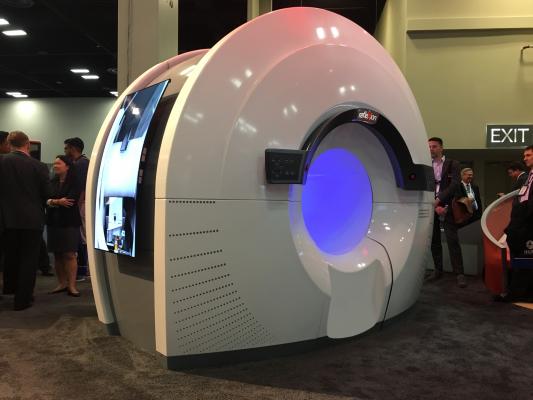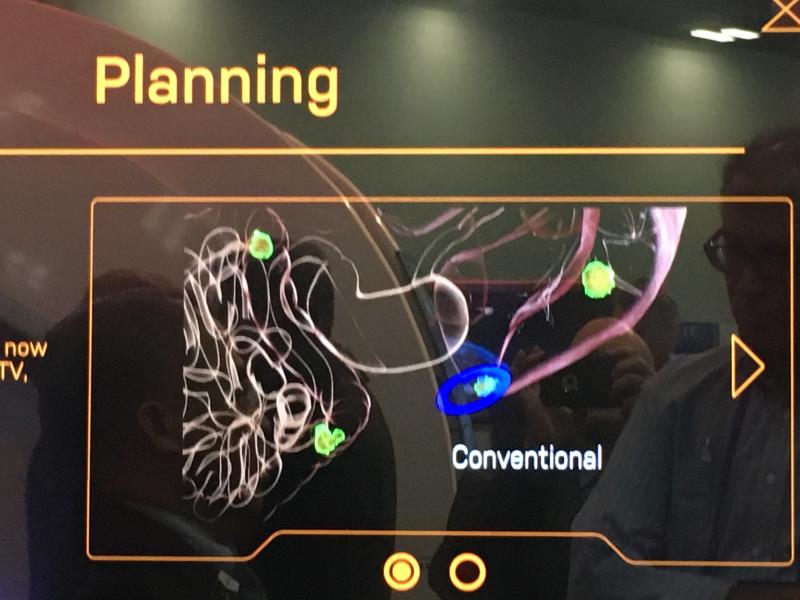
The Reflexion combination PET-CT linac, on display at ASTRO 2018. The system uses PET radiotracer emissions to track tumors directly without the need for margins to account for respiratory motion.
October 30, 2018 - Displayed for the first time at American Society for Radiation Oncology (ASTRO) 2018 annual meeting in October, was RefleXion Medical's biology guided radiotherapy (BgRT). It is the first system to utilize the cancer itself to guide radiation delivery, even in tumors that are moving.
The machine uses positron emission tomography (PET) in a novel way. PET makes use of a small amount of a radioactive tracer to highlight the differences between healthy cells and cancer cells. The most commonly used tracer is FDG, a glucose-based compound, that BgRT uses to determine where the tumor is located. Cancer cells rapidly consume the FDG, which breaks down and instantly produces emissions, thereby signaling their location. Real-time response to these detected emissions is the fundamental principle of BgRT.
“The RefleXion technology could allow us to extend the benefits of radiation to a greater number of patients by being able to efficiently treat several sites at the same time with a high level of confidence,” said Dwight E. Heron, M.D., director of radiation oncology services at University of Pittsburgh Medical Center (UPMC) Hillman Cancer Center, and professor of radiation oncology at the University of Pittsburgh School of Medicine. “Given that the growing body of clinical evidence suggesting that radiotherapy for polymetastatic tumors, or more than three tumors, could be curative, the introduction of BgRT, a radiotherapy approach that may significantly decrease toxicity, is very exciting.”
RefleXion’s BgRT technology was highlight of several scientific presentations at ASTRO.
“We are presenting our results surrounding treatment plans that demonstrates the RefleXion machine may improve radiotherapy delivery for current indications such as head-and-neck, prostate, and esophageal cancers using a conventional CT-guidance approach,” said Jeffrey Wong, M.D. chair and professor, Department of Radiation Oncology at the City of Hope. “When combined with this platform’s potential to expand and efficiently treat metastatic disease, we are even more encouraged with these early results.”
Tumor Tracking Without Margins
RefleXion’s platform enable a new way to manage motion, reduce tumor margins and diminish radiation toxicity, making it feasible to treat multiple tumors in the same session. Current radiotherapy systems require a margin of healthy tissue around the tumor to account for positional uncertainties such as involuntary patient movements and breathing. In many cases, this extra margin results in a significant amount of additional radiation delivered to the patient’s healthy tissue. If too much healthy tissue receives radiation and the patient nears threshold toxicity levels, less therapeutic radiation is available to ensure efficacy of treatment or to treat additional tumors.
By using the tumor’s own PET emissions to guide radiation delivery, treatment margins and the subsequent radiation dose to healthy tissue may be significantly reduced.
Traditionally PET is used to form a complete image that takes up to an hour, during which time the tumor can change location. However, as the FDG is consumed, the emissions it generates are instantly available and reveal the cancer’s location. The RefleXion platform senses these emissions and rapidly responds by sending a beamlet of radiation down the emissions’ pathways toward the originating tumor. By treating tumors that uptake the PET tracer, BgRT makes it feasible to track and treat multiple tumors throughout the body in the same session, a game-changing advance over existing platforms.
"RefleXion’s presence at the ASTRO meeting is the culmination of a 10-year journey that began with a simple question: if a cancer cell emits a signal, can we shoot right back to destroy it?” said RefleXion’s Founder and Chief Technology Officer Sam Mazin, Ph.D. “Using biology to guide radiotherapy, we hope to have the means to turn cancer on itself."
Read more about this start-up company's funding efforts.
For more information: www.reflexion.com



 December 11, 2025
December 11, 2025 









